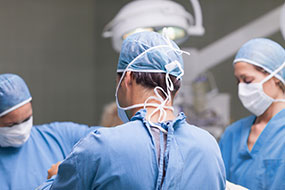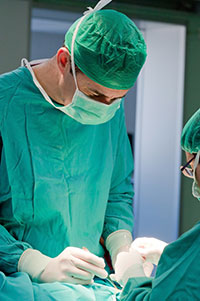-
Mark J. Downey, MD
10 Old Montgomery Hwy #200. Homewood, AL 35209
Appointments & Referrals: (205) 271-6511 - Schedule Now
Anterior Cervical Fusion
Anterior cervical decompression and fusion is removal of disc and/or
bone through an approach through the front of the neck. It is performed
by filling the cavity with bone from the hip and possibly placing screws
and plates to hold the whole construct into place. The typical patient
presents with either arm symptoms such as pain, weakness, numbness
or pins and needles, or symptoms and signs of spinal cord dysfunction,
called "myelopathy." Myelopathy can manifest in a number
of ways including generalized stiffness, difficulty walking, loss of
fine motor control in the hands, etc. Compression of nerves or spinal
cord is typically caused by disc material or bony spurs.
A disc protrusion per se may not cause symptoms. If the anulus is acutely torn, neck pain may result, but the management is usually not operative. If the disc pushes on a nerve, then symptoms down one or both arms may result. The symptoms can include pain, numbness, “pins and needles” and weakness.
Reason for operation
Cervical disc protrusions are not usually operated upon early, but there are some clear situations when a surgeon may recommend early surgery. If there is evidence of severe weakness, early surgery may be offered. If the pain in the arm is so severe that narcotic analgesia is not controlling the pain, early surgery may again be an option. If there is spinal cord compression, typically early surgery is also offered.
If a patient has pain that is not too severe, conservative management is typically initiated. It must be remembered that the vast proportion of patients will settle with time, as long as improvements are noted at 6 weeks, there is minimal or no weakness, and the pain is not excruciating and is manageable with oral analgesia. Then waiting and continuing with conservative therapy is a good option.
If weakness occurs and is not improving, surgery is usually offered. Similarly, if symptoms are not improving at 6 weeks, surgery is an option. In most cases, when managing arm and/or leg pain, surgery is a treatment option that speeds the rate of recovery, remembering that most cases will improve on their own. Again, specific recommendations are tailored to each patient. In the vast number of cases, the goal is control of pain, and an intervention that achieves this and is less invasive than surgery is a reasonable option.
The main reason this form of surgery is performed is to try and reduce the risk of deterioration in spinal cord function. At the extreme end, bad myelopathy patients are wheelchair bound. Coupled with this, even patients with little in the way of symptoms are more at risk of spinal cord injury. This is because the space for the spinal cord is reduced and an accident as trivial as a minor car accident can transiently narrow this space via ligamentous buckling, injuring the cord. Consequently, this surgery is primarily performed as a prophylactic procedure to stop deterioration in the future.
Technique
The operation is preformed under general anesthesia, and as shown above, a cut is made in front of the neck. The food and wind pipe are shifted over, and the operation is performed between these and the blood vessels to the brain. The disc is removed in entirety, and after the spinal cord and nerves have pressure removed from them, bone graft (typically a 7-12 mm block) is taken from the hip and placed into the defect. A plate and screws may be placed over this to keep the graft in place. The operation takes 2-3 hours, and after surgery, a collar is in place for 6 weeks.
Risks
The greatest risk is injury to one or more nerves and this is typically 1-2%. There is a risk of death, quadriplegia or severe spinal cord injury. The risks of infection, bleeding, etc., are similar to those for a laminectomy as are the risks of general complications. There are other risks particular to this operation. Temporary or permanent swallowing problems or hoarseness of voice can occur. They are common temporarily but not so permanently. The hip graft site is more likely to get infected. The combined risks are about 5-10%. The small but real risks from surgery are the reason why all patients with disc protrusions do not immediately have surgery.
Expectations
In uncomplicated cases, the likelihood of good/excellent relief of arm pain is 80-90%. Numbness is slow to recovery and may persist. Weakness also may take 6-12 weeks to return to normal. Pins and needles usually starts to improve immediately.
If the surgery was for myelopathy, as a rule:
- 40% improve
- 40% stay the same
- 20% continue to deteriorate
Recovery
The hip graft site is quite for after surgery and is the main slowdown to mobilization. Some pain on swallowing is not uncommon. Most patients spend 1 night in a HDU setting and mobilize the next day. They typically go home within 3-5 days. A collar is worn for 6 weeks. At this time, repeat X-rays are done, which if satisfactory, lead to discontinuation of the collar.
Nonsurgical options
Despite the length discussion about surgery, most patients get better without surgery.
Conservative therapy comprises:
- Analgesia with NSAIDs (e.g. Mobic, Voltaren or Celebrex)
- Analgesia with other medications such as Tramadol
- Avoidance of neck flexion at computer screens etc. for long periods
- Physiotherapy (traction may help)
- Hydrotherapy (particularly if back pain is a problem)
- Cessation of smoking
- Possibly acupuncture
- Hydrotherapy (particularly if back pain is a problem)
- Perineural steroid and local anesthetic injections
This is not the case for myelopathy secondary to spinal cord compression, in which there are no options except surgery.
Other points
Anterior cervical surgery is being supplanted by
artificial disc surgery. It still plays a role in trauma, deformity
and in the management of older patients with cervical disc disease.
[Top]

Mark Downey, MD
As a physiatrist, Dr. Downey specializes in diagnosis and non-surgical treatment of pain-related spinal disorders. He is board certified in Physical Medicine and Rehabilitation (PM&R) since 2007 and uses his comprehensive spine and musculoskeletal training to determine the appropriate line of treatment for a variety of spinal conditions.
Testimonials
Home Remedy Book

As a community service, Spine Group Alabama mails out a free 36-page Home Remedy Book with customized stretches that can relieve some back and neck pain symptoms. Enter your name and address and we will mail you a copy.
Symptoms Chart

Some symptoms can become permanent if you don’t see the physician with in 24 hours. Find out when you can use “watchful waiting” and when you have an emergency symptom.
Need an Appointment?
Spine Group Alabama specializes in the treatment of back pain, neck pain, herniated discs, and all types of ligament strain related to the neck and low back. Spine Group Alabama is referred back and neck pain patients from across Alabama, including Birmingham, Tuscaloosa, Auburn, Huntsville and Montgomery.
Office Hours:
Monday - Thursday: 8am - 4:30pm
Friday: 8am - 2:30pm
Saturday/Sunday: Closed
(205) 271-6511

